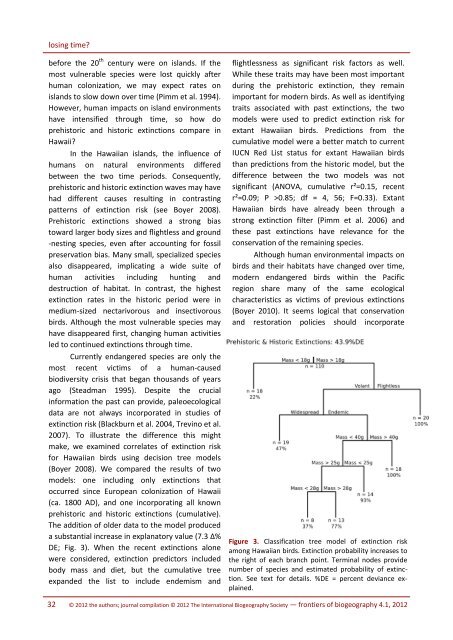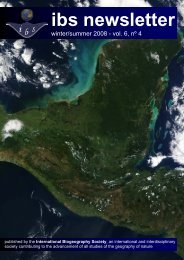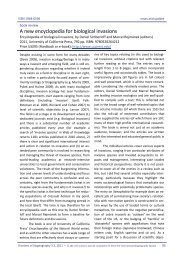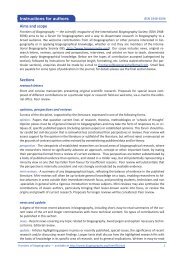losing time?before the 20 th century were on islands. If themost vulnerable species were lost quickly afterhuman colonization, we may expect rates onislands to slow down over time (Pimm et al. 1994).However, human impacts on island environmentshave intensified through time, so how doprehistoric and historic extinctions compare inHawaii?In the Hawaiian islands, the influence ofhumans on natural environments differedbetween the two time periods. Consequently,prehistoric and historic extinction waves may havehad different causes resulting in contrastingpatterns of extinction risk (see Boyer 2008).Prehistoric extinctions showed a strong biastoward larger body sizes and flightless and ground-nesting species, even after accounting for fossilpreservation bias. Many small, specialized speciesalso disappeared, implicating a wide suite ofhuman activities including hunting anddestruction of habitat. In contrast, the highestextinction rates in the historic period were inmedium-sized nectarivorous and insectivorousbirds. Although the most vulnerable species mayhave disappeared first, changing human activitiesled to continued extinctions through time.Currently endangered species are only themost recent victims of a human-causedbiodiversity crisis that began thousands of yearsago (Steadman 1995). Despite the crucialinformation the past can provide, paleoecologicaldata are not always incorporated in studies ofextinction risk (Blackburn et al. 2004, Trevino et al.2007). To illustrate the difference this mightmake, we examined correlates of extinction riskfor Hawaiian birds using decision tree models(Boyer 2008). We compared the results of twomodels: one including only extinctions thatoccurred since European colonization of Hawaii(ca. 1800 AD), and one incorporating all knownprehistoric and historic extinctions (cumulative).<strong>The</strong> addition of older data to the model produceda substantial increase in explanatory value (7.3 Δ%DE; Fig. 3). When the recent extinctions alonewere considered, extinction predictors includedbody mass and diet, but the cumulative treeexpanded the list to include endemism andflightlessness as significant risk factors as well.While these traits may have been most importantduring the prehistoric extinction, they remainimportant for modern birds. As well as identifyingtraits associated with past extinctions, the twomodels were used to predict extinction risk forextant Hawaiian birds. Predictions from thecumulative model were a better match to currentIUCN Red List status for extant Hawaiian birdsthan predictions from the historic model, but thedifference between the two models was notsignificant (ANOVA, cumulative r²=0.15, recentr²=0.09; P >0.85; df = 4, 56; F=0.33). ExtantHawaiian birds have already been through astrong extinction filter (Pimm et al. 2006) andthese past extinctions have relevance for theconservation of the remaining species.Although human environmental impacts onbirds and their habitats have changed over time,modern endangered birds within the Pacificregion share many of the same ecologicalcharacteristics as victims of previous extinctions(Boyer 2010). It seems logical that conservationand restoration policies should incorporateFigure 3. Classification tree model of extinction riskamong Hawaiian birds. Extinction probability increases tothe right of each branch point. Terminal nodes providenumber of species and estimated probability of extinction.See text for details. %DE = percent deviance explained.32 © 2012 the authors; journal compilation © 2012 <strong>The</strong> <strong>International</strong> <strong>Biogeography</strong> <strong>Society</strong> — frontiers of biogeography 4.1, 2012
Felisa A. Smith and Alison G. Boyerpaleoecological information about bird species’ranges and island ecosystems. Fossil evidencesuggests that many species currently limited to asingle island were much more widespread beforehuman contact (Steadman 2006). Thus, Steadmanand Martin (2003) argued that future extinctionsmay be partially offset by selectively translocatingbirds to islands where they once occurred. <strong>The</strong>Marquesas Lorikeet (Vini ultramarina) and thePolynesian Megapode (Megapodius pritchardii)have been reintroduced to well-forested islands intheir former range; in New Zealand, similar islandsanctuaries have been quite successful (Birdlife<strong>International</strong> 2004). Steadman and Martin (2003)provided examples of five more species that couldbenefit from such translocations. Proactiveconservation strategies present opportunities forpaleoecology to step outside its traditionallyretrospective role.Ecological history and climate changeA better understanding of ecological history canenhance our understanding of how organismsrespond to climate change in several ways. Finescaledpaleoclimate reconstructions of the lateQuaternary indicate that climate variability overthe past 100 years does not adequately representthe full range of climate changes that occur inecosystems and, further, that we tend tounderestimate the degree of climatic ‘teleconnections’(Schoonmaker and Foster 1991, MacDonaldet al. 2008). Given that many researchers haveemployed forward projected models to predictfuture climate and ecosystem responses, suchmodels parameterized based only on modernconditions are likely to be misleading (Botkin et al.2007, Williams and Jackson 2007). For someorganisms the paleorecord provides us withmultiple examples of responses to climate shiftsof varying magnitude and frequency. For example,pollen records can provide well-resolvedinformation on regional shifts in abundance, anddistributional movements of plants over the lateQuaternary (Schoonmaker and Foster 1991, Davisand Shaw 2001, Williams et al. 2001, Williams etal. 2002). Similarly, there are detailed records foranimals (Graham 1986, Graham and Grimm 1990,Graham et al. 1996, Hadly 1996). Of particularinterest is the woodrat paleomidden record,which allows fine-grained study of morphologicaladaptation to climate shifts of varying intensity.Woodrats (genus Neotoma) are smallrodent herbivores found throughout much ofNorth America. <strong>The</strong>y are unique in creatingmiddens or debris piles consisting of plantfragments, fecal pellets and other materials heldtogether by evaporated urine (“amberat”). Whensheltered in a rock crevice or cave, the contentsform an indurated conglomerate, which can bepreserved for thousands of years (Betancourt etal. 1990). Microscopic identification andradiocarbon dating of the materials yieldsestimates of diet and vegetation over time.Moreover, the width of the pellets is highlycorrelated with body mass, thus allowingestimates of morphological change of populationsover time; ancient DNA can also be extracted(Smith et al. 1995, Smith and Betancourt 2006).Middens are ubiquitous across rocky arid regionsof the western United States; a well-sampledmountain region may yield upwards of 50–100discretely dated samples spanning 20,000 years ormore. Thus, paleomidden analysis yields a finegrainedcharacterization of both morphologicaland genetic responses of woodrat populations toclimate fluctuations over thousands of years.We have used the woodrat paleomiddenrecord to investigate the response to late Quaternaryclimate change over the western UnitedStates. We find that in most instances woodratsreadily adapted in situ, although there were intervalswhen temperature alterations apparently exceededspecies’ thermal tolerances (Smith andBetancourt 2006, Smith et al. 2009). Overall,woodrats follow Bergmann’s rule: within a regionthe body size of woodrat populations was largerduring cold temporal intervals and smaller duringwarmer episodes. As might be expected, sites locatednear modern range boundaries where animalsapproach physiological and ecological limitsdemonstrate more complicated responses. Atrange boundaries, elevation matters. Populationsat higher elevations adapt, while those lowelevationsites may become extirpated, dependingfrontiers of biogeography 4.1, 2012 — © 2012 the authors; journal compilation © 2012 <strong>The</strong> <strong>International</strong> <strong>Biogeography</strong> <strong>Society</strong>33














